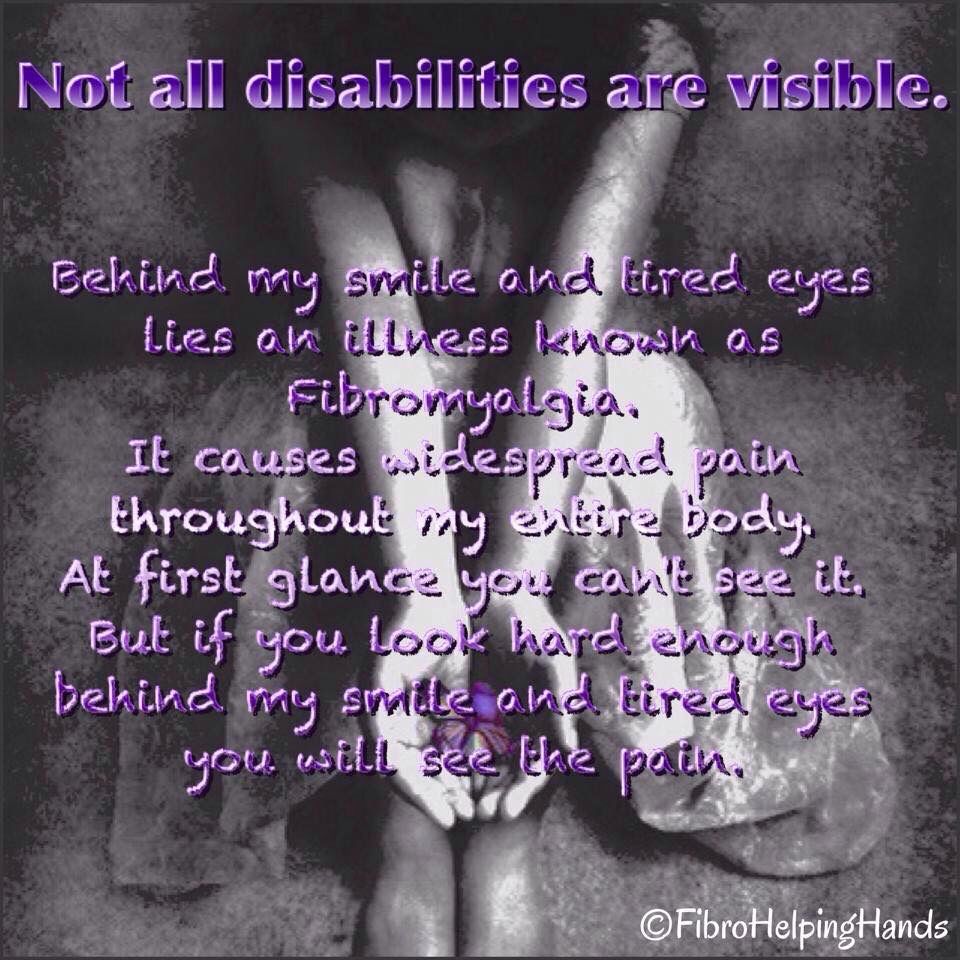I often refer to the fact that I have fibromyalgia in my posts, but many of you might have found your way here through some of my other musings, so I thought I should introduce some of you to this condition.
Fibro-my-WHAT?
By definition, from the National Fibromyalgia & Chronic Pain Association: Fibromyalgia (fy-bro-my-AL-ja) is a complex chronic pain disorder that causes widespread pain and tenderness to touch that may occur body wide or migrate over the body. Along with other symptoms, pain and tenderness wax and wane over time. In addition, most people with this condition experience sleep issues and experience extreme fatigue.
The literal translation of the word fibromyalgia is pain in the muscles, ligaments and tendons. But FMS is much more than pain and presents with many other symptoms that vary from person to person, affecting people physically, mentally and socially.
It is considered a syndrome and not a disease, because it is a collection of signs and symptoms rather than just one. Along with pain and fatigue, there are a myriad of other symptoms, strange and common, and a high rate of co-morbidity with other conditions.
Symptoms and Co-morbidities:
- Morning stiffness
- Insomnia or broken sleep
- Restless leg syndrome
- Headaches/migraines
- TMJ
- Brain fog/cognitive difficulties (forgetfulness, confusion, trouble concentrating, difficulty speaking)
- Chemical sensitivities
- Irritable bowel syndrome or other digestive issues
- Interstitial cystitis or chronic bladder pain
- Endometriosis, painful periods, or pelvic pain
- Costochondritis or non-cardiac chest pain
- Esophageal dysmotility
- Psychological issues (depression, anxiety, or mood swings)
- Neurological disorders (dizziness, muscle weakness, poor coordination or balance, fainting)
- Vertigo
- Increased sensitivity to medications and alcohol
- Paresthesias (nerve pain that can cause burning, tingling, itching sensations)
- Allodynia (skin is sensitive to the touch)
- Sensory issues (sensitive to light, noise, smells)
- Hair loss
- Dystonia (muscle twitches or spasms)
Who Gets It
The numbers aren’t clear as to how many people have FMS. I have seen
anywhere from 4 to 10 million Americans have FMS. The ratio is about 8 to 2, women over men. It occurs in people of all ethnic groups and ages, including children, but is typically diagnosed between the ages of 35-45.
Causes
The medical community has yet to determine a cause for Fibromyalgia, so until there is a cause there can be no cure. But there are some things they suspect can trigger ones brain to start misinterpreting pain signals:
- Genes – it seems to run in families
- Infections – some illnesses and even arthritis can increase your risk
- Emotional or physical abuse, or Post-traumatic Stress Disorder (PTSD) – these situations may change the way the brain handles stress and pain
There are a variety of other primary and secondary risk factors, such as:
- Hormonal imbalances
- Chronic sleep disturbances
- Muscle abnormalities
- Auto-immune diseases
- Abnormal blood flow to the brain
It’s rather like the old saying, “which came first, the chicken or the egg?” Did the hormone imbalance/chronic sleep issue/muscle abnormality cause fibromyalgia or fibromyalgia cause the issue?
Diagnosis
For years there has been no test for fibromyalgia, but insurance companies are starting to approve the use of the FM/a test – “the first objective test to diagnose fibromyalgia via a simple blood test.”
The FM/a® Test is a multi-biomarker-based test which concerns immune system white blood cell chemokine and cytokine patterns. These proteins demonstrate an irregular arrangement in fibromyalgia patients, which enable the FM/a® Test to correctly identify and diagnose this medical disorder.
But mostly there are tests to rule out other conditions. Traditionally, a rheumatologist makes the diagnosis based on listening to symptoms, examining blood tests to rule out other conditions, and a patient being tender in at least 11 out of 18 tender points. New criteria for diagnosis is: at least three months of widespread pain (using a Widespread Pain Index), other symptoms such as fatigue and cognitive difficulties, and no other underlying condition for the symptoms.
Treatments
With Fibromyalgia, the medical community tends to treat the symptoms you are having. There are promising new studies on inflammation and neuroinflammation (of the nervous tissues) that could lead to new treatment options. There are some promising ones on the horizon, but for now, doctors are prescribing your usual suspects.
Drugs
- Anti-depressants like Cymbalta or Savella
- Muscle Relaxers like Cyclobenzaprine
- Anti-seizure drugs like Gabapentin or Lyrica
- Pain medication (over the counter or otherwise)
Alternative Therapies
- Physical or Occupational therapy
- Counseling
- Massage therapy
- Acupuncture
- Ultralaser
- Exercise like yoga or tai chi
- CBD Oil
Lifestyle Changes
- Diet
- Stress Management
- Sleep Hygiene
Moving Forward
From my research into this subject I have found that everyone with Fibromyalgia presents different symptoms, co-morbidities, levels of pain and pain tolerance, and ability to manage through life with their symptoms. I considered myself “high-functioning,” as most days I am able to work, exercise, and go about my life. I do have days where I am wake up stiff and in pain, I move slow throughout the day or am even unable to get off of the couch. But there are many others that are so crippled by this condition that they have had to go on disability because they are unable to work with the daily pain they suffer.

Often termed an “invisible illness” because there isn’t an demonstrable way to show pain and fatigue. Nonetheless, those who suffer deserve your understanding and compassion.
It has taken years to find what works best for me, having adopted an attitude of “I have fibromyalgia, it does not have me!”
Tweet
Due to my high sensitivity to drugs and chemicals, I personally combat my condition with healthy lifestyle choices and a variety of natural ways to manage my pain. Read more about my strategies here:
- Fight Fibromyalgia with Your Diet
- Six Tips for Relieving Pain Naturally
- How to Be Resilient with Fibromyalgia
- The Benefits of Yoga for Fibromyalgia
- Why I Practice Yoga for Pain
- How to Sleep Better

I hope I have shed some light on this complicated condition for you. Do you have fibromyalgia? What strategies do you use for managing your symptoms?
Cheers!
Cynthia



Great overview for folds that do not know what fibro is. I use your mantra too, I have fibro, it does not have me. I believe it should be our battle cry! There is the FM/a blood test, finally approved by insurance companies… but its new. Being able to manage symptoms is so different for each person, isn’t it? This is no cookie cutter disease! (Or syndrome.) ~Kim
LikeLiked by 1 person
Good to see it is finally getting approval! I am going to update my post. Thanks Kim!! ❤
LikeLiked by 1 person
Cool. Yes, finally… approved.
LikeLiked by 1 person
❤️❤️❤️❤️❤️ for you. I needed to read this to remind myself that it is not all in my head.
LikeLiked by 1 person
Definitely not!!! You are NOT alone. Gentle hugs!💜
LikeLiked by 1 person
What if I fail the FM/a test??
LikeLike
Great post! 🙂
LikeLiked by 1 person
😊 Thank you! 💜
LikeLike
It’s so good to know that I’m not the only one with chemical sensitivities. I cannot take most medication due to allergic reactions or it will cause a migraine. Great research!
LikeLiked by 1 person
Thank you! Yes that is one of the worst things, just having to deal with the pain without pain relief. Gentle hugs and good luck to you!
LikeLike